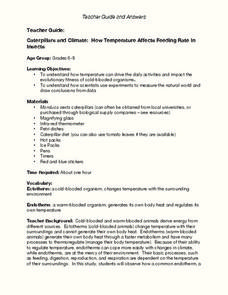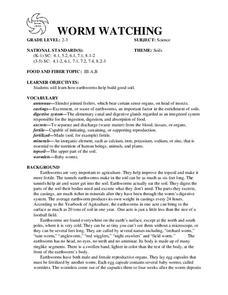Smarter Balanced
Classifying Vertebrates
What features do scientists use to classify animals into groups? Class groups examine a series of paired images of vertebrates (a bass and a trout, a toad and a newt, a crocodile and a tortoise, an owl and a robin, a tiger and a bear)...
Howard Hughes Medical Institute
The Making of the Fittest: The Birth and Death of Genes
Adaptations must be made as environments change. This fabulous presentation features Icelandic icefish, a transparent, scaleless specimen that even has colorless blood. Genetics and adaptations concepts are explored as scientists study...
Curated OER
Caterpillars and Climate: How Temperature Affects Feeding Rate In Insects
Do you eat more when you are hot or when you are cold? Young scientists observe the eating pace of two caterpillars at different temperatures. The differences in endotherm and ecotherm animals' ability to adjust to temperature change...
Curated OER
Loggerhead Turtle Fun Facts
Learners study loggerhead turtles and learn facts about reptiles. In this turtles lesson, students read information about loggerhead turtles and study their various sections and characteristics. Learners then make their own sea turtle.
Curated OER
What Increases the Risk of Cardiovascular Disease?
Students analyze the risk factors for cardiovascular disease and classify them according to whether or not they are controllable. They discover how to reduce the probability of high blood pressure through diet and exercise.
Curated OER
The Invisible Zoo
Students explore how infrared images give biologists or zoologists detailed information on how warm-blooded and cold-blooded animals thermoregulate. They are introduced to infrared imaging technology and the information that such images...
Nuffield Foundation
Monitoring the Body's Reaction to Stress
When stressed, do you prefer the fight or flight response? Scholars observe, measure, and identify the body's response to stress using a well-researched methodology. They learn about the autonomic nervous system, hormones, and more.
Desert Discovery
Leaping Lizards
Here is a fine biology lesson that introduces youngsters to reptiles. They study their feeding habits, their habitats, and the adaptations they must make to survive in their environments. The outstanding lesson includes two excellent...
Curated OER
Science NetLinks: Hollywood Dinosaurs
Middle schoolers use relevant evidence and logical reasoning to construct theories for dinosaur behavior. They examine recent evidence that challenges a prevailing dinosaur theory.
Curated OER
Turtle and Tortoise Preschool Lesson Plan
One of the best parts about teaching the littlest learners is that you can create thematic lessons that use one topic to address every subject. Here is a nice set of thematic teaching ideas that uses turtles and tortoises to teach...
Umaine Museum of Art
Bony Fish Anatomy Worksheet
Take time to appreciate the beauty in the anatomy of animals with this cross-curricular art and science activity. After viewing examples of fish-themed artwork, children complete the included worksheet by labeling the different parts of...
Macmillan Education
The Tell-Tale Heart
Rather than who done it, the mystery literary detectives have to solve as they examine the evidence found in Edgar Allan Poe's famous "The Tell-Tale Heart" is why did he do it?
Curated OER
Coqui Frog Populations
Students research Coqui frogs. Students explore the life cycle of coqui frogs and discover how these frogs have become an invasive species in Hawaii.
Curated OER
Marine Mammal Diving Reflex
Tenth graders discuss marine mammal diving reflex, and measure pulse rate while holding their breath under three conditions: control, warm water, and ice water to determine if humans exhibit marine mammal diving reflex.
Curated OER
WORM WATCHING
Students investigate how earthworms help build good soil. They examine the worms carefully to find the ringlike segments and swollen band at the front of the earthworm's body. Students take turns dampening the soil every day and adding...
Curated OER
Outdoor Survival
Students are introduced to basic outdoor survival concepts. They identify the seven basic needs for survival. Students describe the symptoms and treatment for frostbite and hypothermia. They compare and contrast the value of different...
Curated OER
Habitat Hopscotch
Students analyze different habitats. In this habitat lesson, students evaluate what animals need in their habitats. Students participate in the game Habitat Hopscotch.
Curated OER
Coma
Students examine the diving reflex response which allows a person to stay underwater for an extended period of time. They complete an experiment to compare resting pulse rate and pulse rate when their face is submerged in water.
Other popular searches
- Cold Blooded Animals
- Cold Blooded Animals
- Warm Blooded Cold Blooded
- Warm and Cold Blooded Animals
- Cold Blooded Vertebrates
- Warm Blooded Cold Blooded
- Are Dinosaurs Cold Blooded
- Warm Cold Blooded
- Cold Blooded Reptiles
- Mammals and Cold Blooded
- Cold Blooded Respiration
- Warm Blooded, Cold Blooded



















